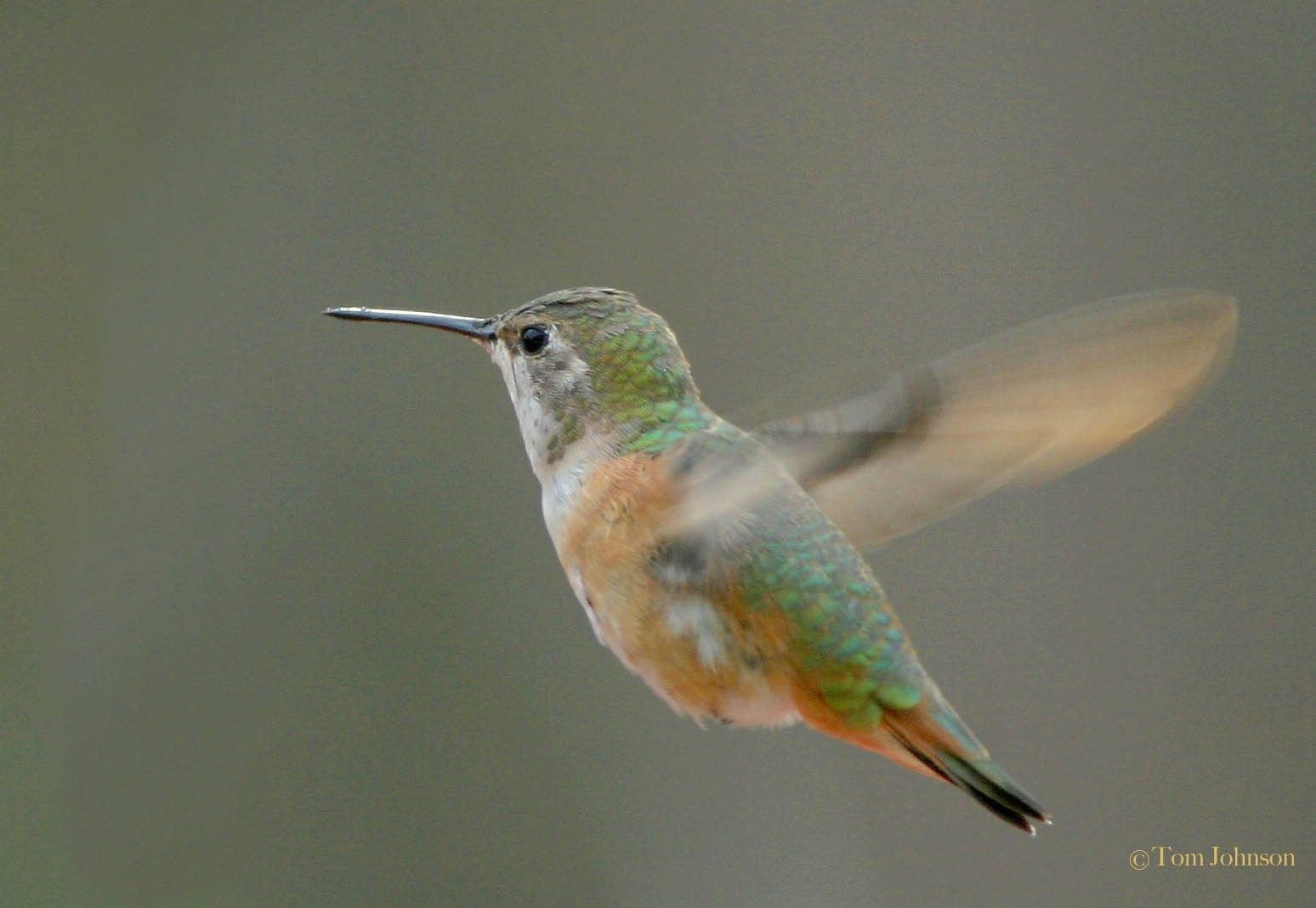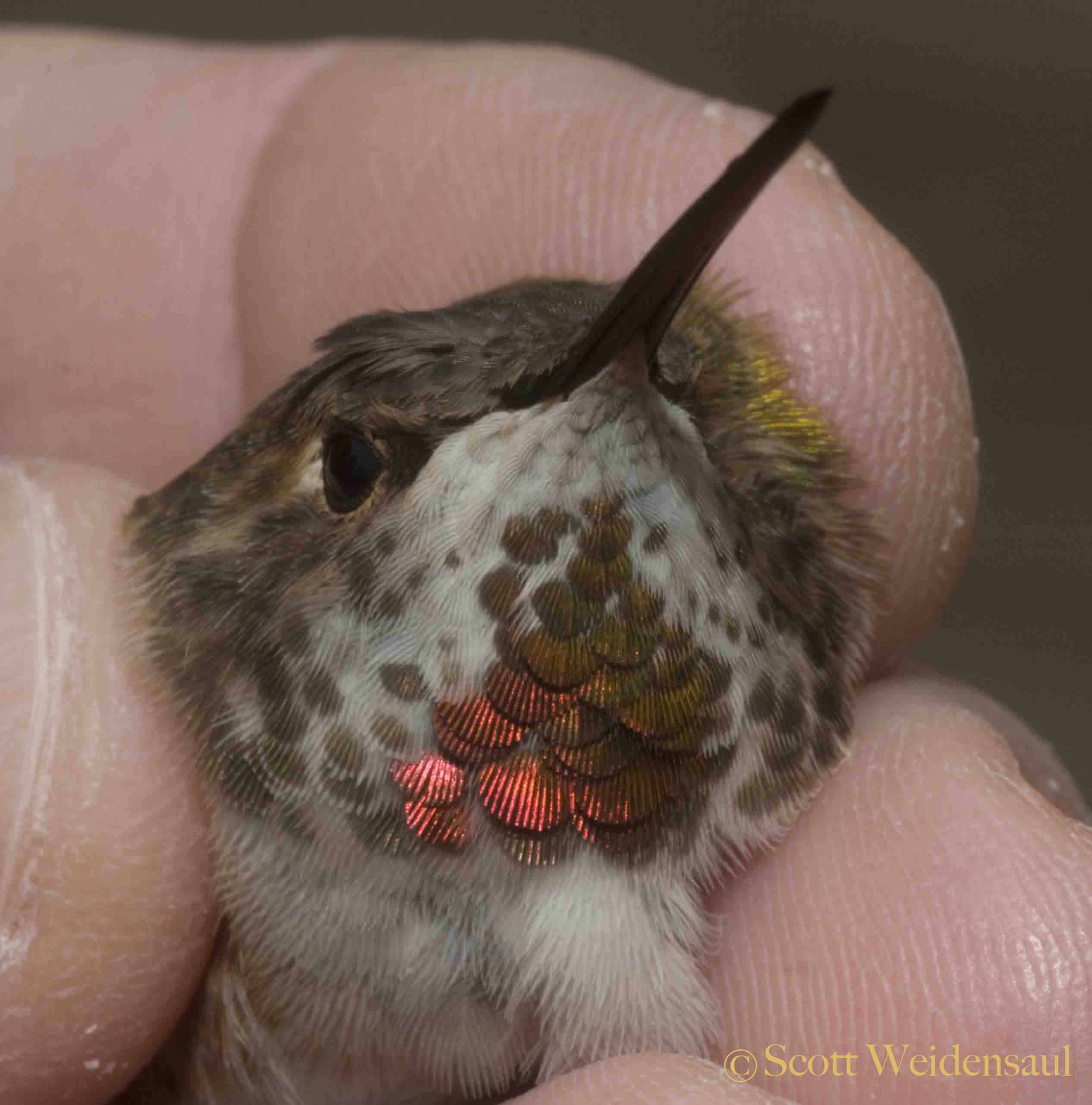Hummingbirds
 A female rufous hummingbird in Pennsylvania in November - part of a newly evolving migration route for this species. (©Tom Johnson)Traditionally, only one species of hummingbird - the ruby-throated - was found east of the Great Plains, departing each September or October to winter in the tropics. But in recent years, growing numbers of western hummingbirds of almost a dozen species have been appearing in the East and Southeast, usually showing up in autumn and winter. Scott Weidensaul is part of a continental network of dozens of hummingbird banders trying to document and understand this emerging phenomenon.
A female rufous hummingbird in Pennsylvania in November - part of a newly evolving migration route for this species. (©Tom Johnson)Traditionally, only one species of hummingbird - the ruby-throated - was found east of the Great Plains, departing each September or October to winter in the tropics. But in recent years, growing numbers of western hummingbirds of almost a dozen species have been appearing in the East and Southeast, usually showing up in autumn and winter. Scott Weidensaul is part of a continental network of dozens of hummingbird banders trying to document and understand this emerging phenomenon.
Each fall and early winter, Weidensaul traps and bands vagrant western hummingbirds in the mid-Atlantic region and New England. Most of these wanderers are rufous hummingbirds (Selasphorus rufus), which breed from the northern Rockies and Pacific Northwest to southcentral Alaska, and which ordinarily winter in central Mexico. Smaller numbers of the nearly identical Allen's hummingbird (S. sasin) of California, as well as calliope, black-chinned, Anna's and broad-tailed hummingbirds, are also regularly reported from the region. Sunlight glints off the gorget feathers of this adult female rufous hummingbird, about to be released. (©Scott Weidensaul)
Sunlight glints off the gorget feathers of this adult female rufous hummingbird, about to be released. (©Scott Weidensaul)
However, changes in the landscape, and the ever-warmer winters of the past century, may be combining to make the East and especially the Southeast perfectly hospitable to these birds. Those that survive and return to their breeding grounds are, in all likelihood, passing on their once-unfavorable genes to new generations. Banding studies in the East suggest the number of wintering hummingbirds is increasing dramatically, and that we may be seeing the rapid evolution of a new migratory route and wintering area for these birds.
Although most Eastern homeowners take down their hummingbird feeders when the last rubythroats depart in September, these western species don't usually appear until much later in the fall - October, November or even December in the latitude of Pennsylvania. For that reason, it's a good idea to leave at least one feeder up and filled through at least Thanksgiving, even if it freezes at night - and to contact a bander (below) if you have a hummingbird in late autumn or winter.
These hummingbirds do not need to be "rescued," as they sometimes are  Pennsylvania's first-ever Allen's hummingbird, banded Dec. 12, 2009 in Leola, PA. (©Scott Weidensaul)by well-meaning but misguided people who think it is better to keep them in captivity, or ship them south. This is illegal as well as unwise. The hummingbirds are healthy and well-adapted to their new situation, and have already migrated thousands of miles to get there. Please enjoy them, but don't interfere.
Pennsylvania's first-ever Allen's hummingbird, banded Dec. 12, 2009 in Leola, PA. (©Scott Weidensaul)by well-meaning but misguided people who think it is better to keep them in captivity, or ship them south. This is illegal as well as unwise. The hummingbirds are healthy and well-adapted to their new situation, and have already migrated thousands of miles to get there. Please enjoy them, but don't interfere.
Weidensaul is part of large, collaborative effort on the part of dozens of hummingbird banders in the East, Midwest and South who are banding western hummers to better understand this phenomenon. The results can be spectacular; in January 2010, bander Fred Dietrich banded a rufous hummingbird in Tallahassee, FL, which was recaptured six months later in Chenega Bay, Alaska. The information gleaned from such research is vital to understanding how hummingbird populations and migration routes are changing.
 A hummingbird clearwing, one of several day-flying moths that look and act a great deal like hummingbirds. (©Scott Weidensaul)(Homeowners are often fooled by hummingbird moths, a group of day-flying sphinx moths that look, fly and feed remarkably like hummingbirds, hovering at flowers to drink. Some species are rusty orange in color, like a male rufous hummingbird.)
A hummingbird clearwing, one of several day-flying moths that look and act a great deal like hummingbirds. (©Scott Weidensaul)(Homeowners are often fooled by hummingbird moths, a group of day-flying sphinx moths that look, fly and feed remarkably like hummingbirds, hovering at flowers to drink. Some species are rusty orange in color, like a male rufous hummingbird.)
Watch a video here from National Audubon's "Audubon at Home" that shows Scott Weidensaul banding an Allen's hummingbird in southeastern Pennsylvania.
Common questions about fall/winter hummingbirds:
